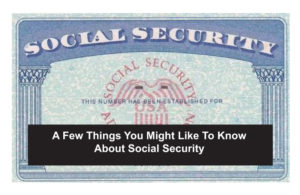BLOG
Few Good Things to know about Social Security
By Rick Mapel, Certified Public Accountant
 If you are receiving Social Security, you can earn up to $18,240 before your payments are reduced one dollar for every two dollars over this amount. These earnings would be from a salary or self-employed, it does not include sources of income that do not pay into Social Security/ Medicare, such as interest income.
If you are receiving Social Security, you can earn up to $18,240 before your payments are reduced one dollar for every two dollars over this amount. These earnings would be from a salary or self-employed, it does not include sources of income that do not pay into Social Security/ Medicare, such as interest income.
Contrary to popular belief, you do not lose these dollars that are reduced. They go into an escrow account in your name and when you reach FRA (full retirement age) these are added back into your payments. If turning 66 in 2020, you can earn up to $48,600 before payments are reduced. After that, there is no longer an earning limitation and you can make as much as you want without a reduction in payments.
The earning cap for 2020 is $137,700. What this means is that your earned income up to this amount pays the full social security and Medicare tax (7.65% for W-2 earner and 15.3% for self-employed). After this amount, you only pay the Medicare portion (1.45%/2.9%). If you are looking at high income, it may be to your advantage to group income into certain years and go above this cap. Plus, this could also play a factor with Income Averaging. If you are paying for Medicare out of your Social Security, for 2020 $144.60 will be taken out of your pay. For high income people, this amount goes to $202.40 and up.
Taxing Social Security:
Unfortunately, Social Security for many of us is not tax free. If you are single and have combined income over $25,000 up to 50% of benefits will be taxable, and if over $34,001 up to 85% of benefits will be taxable. For married and have combined income over $32,000 up to 50% will be taxable and over $44,001 up to 85% will be taxable. Combined income means other taxable income, tax-exempt income, and one-half of your social security payments.
Social Security Coverage:
Everyone needs 40 quarters of coverage to receive their full Social Security. This means 10 years of four quarters. For 2020, each quarter is $1410 of earnings, so $5640 for a year. If you are self-employed and made a profit of less than that, or even have a loss, you should consider filing optional self-employment. By doing this you are “kicking” in enough Social Security to cover your four quarters. Since Social Security is based on your top 35 years, this could benefit you.
There are several reasons why this may be also to your advantage. One of course, is to give you more retirement with Social Security. Second is Earned Income Credit, if you have young kids at home, by doing this you could potentially increase your refund as you need a positive income to get the best credit. For self-employed, if you have a loss, by using optional SE, it creates a positive profit, thereby allowing you to deduct your self-employed health insurance, and offset some of the SE tax you will pay by doing the optional. If you are self-employed, don’t forget that Medicare premiums (Parts A-D) are deductible as self-employed health insurance. If you would like to have federal withholding taxes taken out of your Social Security check, file Form W-4V. You can have 10, 12, or 22% deducted from your payments.
Rick Mapel is a Certified Public Accountant (licensed in Virginia and North Dakota) and the owner of Rick Dean LLC.
